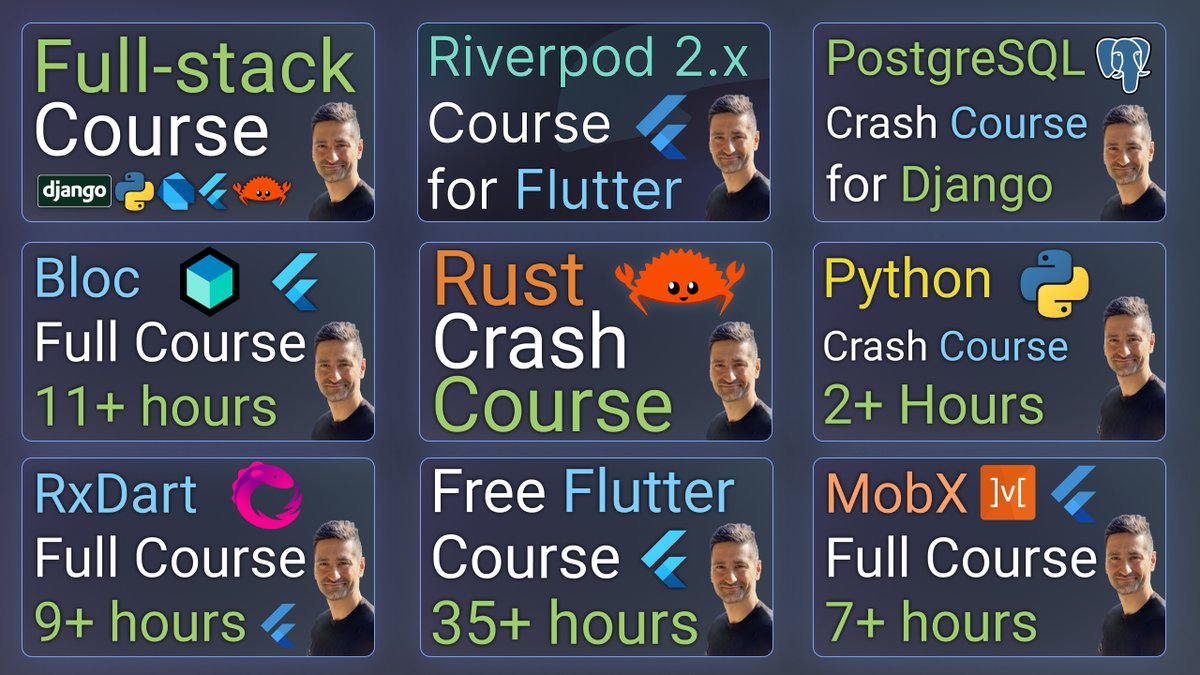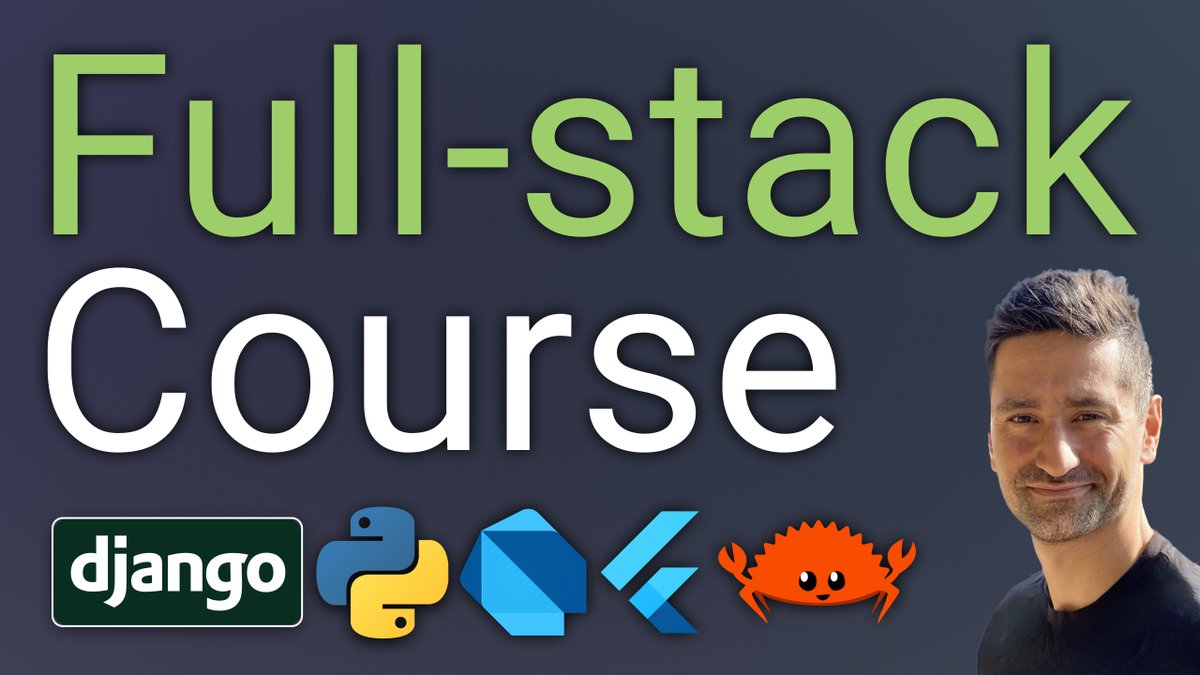Discover and read the best of Twitter Threads about #django
Most recents (14)
🦄I have created so many #free #YouTube #courses that even I've almost lost count! Here is a list of all my courses (#Flutter 💙, #Rust 🦀, #Python 🐍, #Django), with explanations and links! A #thread 👇🏻 

Free #Full-#stack Course
In this course we will create a backend with RESTful API endpoints together with JWT token authorization using Django and Django REST Framework to serve our Flutter and Rust clients (This is an ongoing course) youtube.com/playlist?list=…
In this course we will create a backend with RESTful API endpoints together with JWT token authorization using Django and Django REST Framework to serve our Flutter and Rust clients (This is an ongoing course) youtube.com/playlist?list=…

#Riverpod 2.x #State #Management Course for #Flutter Developers (17 hours long course)
In this course we will develop a fully functioning Instagram application with Flutter and Riverpod where users can upload photos, videos, comment, like and more!
In this course we will develop a fully functioning Instagram application with Flutter and Riverpod where users can upload photos, videos, comment, like and more!

It may seem simple as you may have some data in tables (hello, MySQL) and you want them on a web page (hi, <table>). But you start joining data from other tables and you end up displaying a tree in a table. How? You never know how to do it until you try to use that. UX!
(2/6)
(2/6)
¿Aún no sabes por qué aprender #Python?
Hoy te traemos 8 razones para convertirte en especialista del lenguaje de programación más requerido en el mercado ⚡🧵
Hoy te traemos 8 razones para convertirte en especialista del lenguaje de programación más requerido en el mercado ⚡🧵
1️⃣ Es el lenguaje ideal para comenzar a programar.
Es de código abierto y no debe ser compilado. Con la motivación correcta, podrás dominar esta herramienta a corto plazo. Pronto te encontrarás desarrollando tus primeras aplicaciones sin problema 💪
Es de código abierto y no debe ser compilado. Con la motivación correcta, podrás dominar esta herramienta a corto plazo. Pronto te encontrarás desarrollando tus primeras aplicaciones sin problema 💪
2️⃣ Tiene una sintaxis accesible.
La legibilidad y claridad del código permite a personas con un nivel de 'alfabetización' básico en lenguajes de programación, escribir instrucciones o realizar procesos específicos de forma sencilla.
La legibilidad y claridad del código permite a personas con un nivel de 'alfabetización' básico en lenguajes de programación, escribir instrucciones o realizar procesos específicos de forma sencilla.
Aqui vamos de nuevo, A petición de @ramloarc
vamos a empezar a compartir más contenido #backend
Seguimos con:
¿Cómo aprendí #Django y #python?
La vieja confiable documentación.
Pásenle que hay mucho trabajo remoto
docs.python.org/3/tutorial/ind…
vamos a empezar a compartir más contenido #backend
Seguimos con:
¿Cómo aprendí #Django y #python?
La vieja confiable documentación.
Pásenle que hay mucho trabajo remoto
docs.python.org/3/tutorial/ind…
@ramloarc Mi primer sitio web como #backend yo lo hice con #Django, quede enamorado del framework
Sigan el paso a paso de esta documentacion y tambien tendran su sitio
docs.djangoproject.com/en/3.2/intro/t…
Sigan el paso a paso de esta documentacion y tambien tendran su sitio
docs.djangoproject.com/en/3.2/intro/t…
@ramloarc Hace 2 años me puse a hacer mi "proyecto Insignia", donde aplique la mayor cantidad de habilidades posibles.
github.com/luismejiadev/s…
github.com/luismejiadev/s…
A petición de @ramloarc vamos a empezar a compartir más contenido #backend
Empezando con lo que trabajo en GitLab.
¿Cómo aprendí #rails #ruby ?
La vieja confiable documentación.
Pásenle que hay mucho trabajo remoto
guides.rubyonrails.org/getting_starte…
Empezando con lo que trabajo en GitLab.
¿Cómo aprendí #rails #ruby ?
La vieja confiable documentación.
Pásenle que hay mucho trabajo remoto
guides.rubyonrails.org/getting_starte…
@ramloarc Si de verdad quieren entender el funcionamiento del MVC de Rails,
hagan una prueba creando una mountable app, que en #rails serian #railsengines
#backend
guides.rubyonrails.org/engines.html
hagan una prueba creando una mountable app, que en #rails serian #railsengines
#backend
guides.rubyonrails.org/engines.html
@ramloarc Hace 3 años, hice una prueba técnica básica,
Crear una API con #ruby #Rails y luego mostrar esos datos en un grafico de lineas.
Por acá pueden echarle un ojito
#backend
github.com/luismejiadev/c…
Crear una API con #ruby #Rails y luego mostrar esos datos en un grafico de lineas.
Por acá pueden echarle un ojito
#backend
github.com/luismejiadev/c…
LIMIT considered harmful in #PostgreSQL, a brief thread. 1/n
LIMIT can cause very strange planning issues in PostgreSQL, and you shouldn't use it unless it's definitely required. 2/n
(Of course, LIMIT *is* sometimes required, so use it if you need to!) 3/n
👇🧵
After creating our #Django app
Let's create and fill in the urls.py and views.py files
ps please follow if you like this thread ☺️
thanks!🙏🙏🙏
After creating our #Django app
Let's create and fill in the urls.py and views.py files
ps please follow if you like this thread ☺️
thanks!🙏🙏🙏
1/13
By default django doesn’t create a urls.py file in django app folder, so we need to do that manually
By default django doesn’t create a urls.py file in django app folder, so we need to do that manually
2/13
Now that we have created our app and linked it to our project
We can create the location and content of our page
Lets go to views.py for the content
#100DaysOfCode
Now that we have created our app and linked it to our project
We can create the location and content of our page
Lets go to views.py for the content
#100DaysOfCode
Starting a video thread!! 🧵👇
In this video thread you will find 8 #python videos explaining the basics in python for beginners!
Every video is about 100 seconds :)
quick disclaimer it's obviously not covering everything about python ;)
In this video thread you will find 8 #python videos explaining the basics in python for beginners!
Every video is about 100 seconds :)
quick disclaimer it's obviously not covering everything about python ;)
2/8 Lists
Lists is a type of variable. Lists allow you to store multiple pieces of information individually:
#100DaysOfCode #100DaysOfPython
Lists is a type of variable. Lists allow you to store multiple pieces of information individually:
#100DaysOfCode #100DaysOfPython
Last thread🧵 we created a django project
And went over the basic structure of a website and the files
In this thread we will create a django app
would me the world if you could retweet or like this thread🙏🙏🙏
What we covered so far 👇
And went over the basic structure of a website and the files
In this thread we will create a django app
would me the world if you could retweet or like this thread🙏🙏🙏
What we covered so far 👇
1/11
Terminal
Navigate to our folder: Cd project
Create a project folder: Mkdir my project
Create virtual environment: Python -m venv ./myvenv
Install django - pip install Django
Create django project - Django-admin startproject myfirstproject
Terminal
Navigate to our folder: Cd project
Create a project folder: Mkdir my project
Create virtual environment: Python -m venv ./myvenv
Install django - pip install Django
Create django project - Django-admin startproject myfirstproject
2/11
Navigate in the terminal to the folder of our django project which we created last time and run the virtual environment
Navigate in the terminal to the folder of our django project which we created last time and run the virtual environment
Beginning a thread🧵 about the basics in #Python you need to know for #Django👇
Django is a #webframework to build interactive #websites for Python and is great for fast #development
Django is a #webframework to build interactive #websites for Python and is great for fast #development
1/ 19 Variables are used to store information, so that they can be used later on in your code.
In Python a ‘string’ is text and a ‘integer’ or ‘float’ is a number
‘car_brand’ and ‘brand_type’ are variables in the example below
Variables can be stored inside other variables
In Python a ‘string’ is text and a ‘integer’ or ‘float’ is a number
‘car_brand’ and ‘brand_type’ are variables in the example below
Variables can be stored inside other variables

2/19
No special signs are allowed to be used in the name of variables, except for ‘_’ like.
Numbers are allowed in the name of a variable, but not at the start
So ‘1car’ is not OK and ‘car1’ is OK.
No special signs are allowed to be used in the name of variables, except for ‘_’ like.
Numbers are allowed in the name of a variable, but not at the start
So ‘1car’ is not OK and ‘car1’ is OK.
building a long-life (10yrs+) graph-backed web service for @pariyatti (a non-profit). we're planning to use #neo4j
i have some questions.
i have some questions.
#python + #django support seems... weak, at best? (latest commits to `neomodel` and the django plugin are 2019/2018 with no support for neo4j 4.x)
is this a misconception on my part? i'd love a shout out from people happily building webapps with #neo4j on #python out there
is this a misconception on my part? i'd love a shout out from people happily building webapps with #neo4j on #python out there
#ruby and #rails support seems okay. #activegraph is a thing and there was a commit this week. the design seems sane.
i have 10-year-old rails apps, though. they... don't work. the ruby & rails ecosystem isn't really geared toward "boring things that will work in 10-20 years"
i have 10-year-old rails apps, though. they... don't work. the ruby & rails ecosystem isn't really geared toward "boring things that will work in 10-20 years"
🤔 How do you currently solve #authentication?
Here’s a summary of #AuthN solutions from this #HackerNews thread:
news.ycombinator.com/item?id=221571…
👇👇👇
Here’s a summary of #AuthN solutions from this #HackerNews thread:
news.ycombinator.com/item?id=221571…
👇👇👇
#Firebase Auth
- Free
- Scalable
- Easy to get up & running
- Good docs
- Social auth
- Integrate with any OAuth system via custom tokens
- Email verification
- SMS auth, passwordless login (“magic links”)
- SDK’s for different languages
@Firebase | firebase.google.com/docs/auth
🔗
- Free
- Scalable
- Easy to get up & running
- Good docs
- Social auth
- Integrate with any OAuth system via custom tokens
- Email verification
- SMS auth, passwordless login (“magic links”)
- SDK’s for different languages
@Firebase | firebase.google.com/docs/auth
🔗
#KeyCloak by @RedHat
- Open source
- Social auth, SSO
- Good docs & support
- Easy deploys within a #Docker container
- OAuth2, OIDC, SAML, MFA, themes, & more
@keycloak | keycloak.org
🔗
- Open source
- Social auth, SSO
- Good docs & support
- Easy deploys within a #Docker container
- OAuth2, OIDC, SAML, MFA, themes, & more
@keycloak | keycloak.org
🔗
I know you have heard of password #Salts which are similar to Nonces and used to add uniqueness to passwords and protect against pre-computed hashes (rainbow tables).
Did you also know about password #Peppers ? They are equally important too.
Did you also know about password #Peppers ? They are equally important too.
1/ #Django will use watchman to do autoreload if it's installed since 2.2. The default reloader runs stat on all the files in your project once per second, whereas watchman will use os file system events, which is much more efficient.
2/ I never cared about this until I spent an afternoon figuring out why Docker for Mac's hyperkit process sits on 120% - 150% cpu use while running my mid sized django project in a container.
3/ i used 'docker stats' to deduce which container, then 'top' and 'ps auxf' to work out which python process was the problem. Then did a thread dump of the django server using faulthandler.dump_traceback() triggered from an API call, and then 'docker log'


